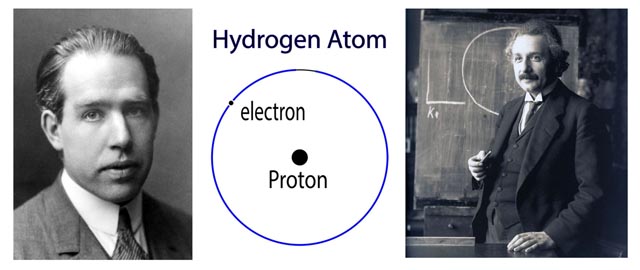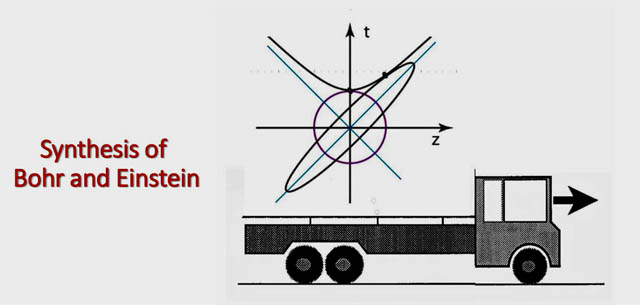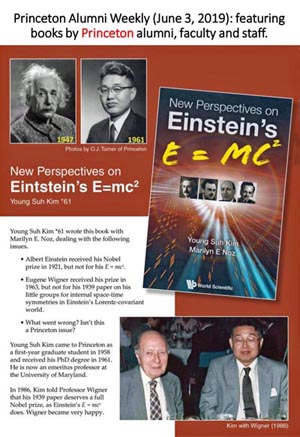Is it difficult to understand Einstein?
- No, it is very easy, if his theories are translated into cartoons.
- Young Suh Kim
Professor of Physics Emeritus
University of Maryland
College Park, Maryland 20742, USA. - What do they say about him?
- Video from the Marquis Who's Who.
- Video from the IAOTP (International Association of Top Professionals).
- Toyotomi Hideyoshi is a very important person in Japanese history. He brutally eliminated the rival warlords and unified Japan into one country.
His nickname in Japan is "Osaru-San" (Mr. Monkey). He is a Monkey to human eyes, but he is a Human if monkeys look at him. How did he appear to his own eyes? Go to the Appendix 1.

This is the simplest and most entertaining illustration of the philosophy of Immanuel Kant. The same thing could appear differently depending on the observer's environment or status of mind.
- We can look at him from different directions, and he appears differently.

- If your name is Albert Einstein, you would ask how Toyotomi appears to you when you are on a moving bicycle or on a moving train.
When Einstein was a high-school student, he became brain-washed by the philosophy of Immanuel Kant. This led to his special theory of relativity which produced
This formula serves as Einstein's nickname, and is one of the most important formulas for human civilization.
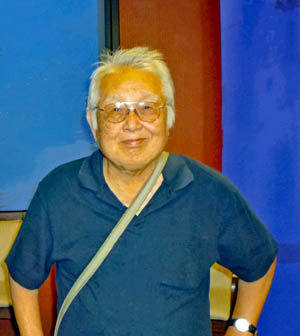
|
|
|
Further Contents of E = mc2
- One hundred year ago, Niels Bohr was worrying about the electron
orbit of the hydrogen atom. Albert Einstein was interested in how things
appear to moving observers. Their concerns led to the present form
of quantum mechanics and the special theory of relativity, respectivly.
- Bohr and Einstein met occasionally to discuss physics. Then, did they
talk about how the hydrogen atom appears to moving observers? The
same question is how the moving atom appears to a stationary observer.
If Bohr and Einstein discussed this problem, there are no written records on this issue. This became the homework problem for the younger generation of physicists.
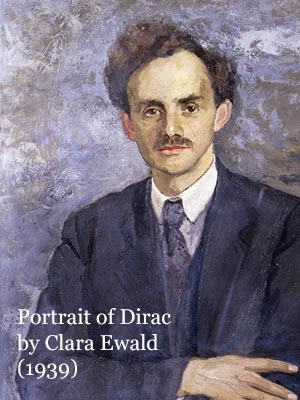
- I am not the first person to worry about this problem.
Paul A. M. Dirac (1902-1984, Nobel-1933) published three
important papers (1927, 1945, 1949) on moving (Lorentz-boosted)
localized wave functions for bound states.
Click here for the references to
those papers.
- In 1962, I was the youngest assistant professor of physics at
the University of Maryland, and I was assigned to serve as the
personal assistant (= servant) to
Professor Dirac who visited the University for one week.
I learned his physics directly from him.
When I met him in 1962, Dirac had submitted his 1963 paper to the Journal of Mathematical Physics where he explored the possibility of deriving Einstein's special relativity (Lorentz covariance) from Heisenberg's uncertainty brackets.
- However, it took me many difficult years to understand what Dirac
really had in mind. His papers are like poems and enjoyable to read,
but it was difficult to understand them,
for the following reasons.
- He did not quote his own earlier papers, presumably because he thought
he was presenting new ideas in every paper he wrote.
Thus, it is fun to integrate Dirac's papers, as we could build canals by connecting the lakes. His papers are like the existing lakes:
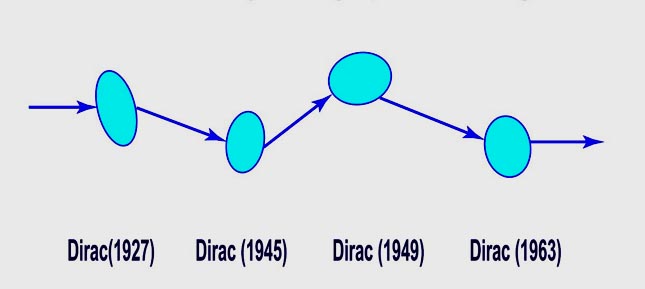
- His papers are like poems. It is really enjoyable and exciting to read
those poems. However, there are no figures in those papers.
It requires only two-dimensional geometry to translate his poems into cartoons. Let us see the cartoons.
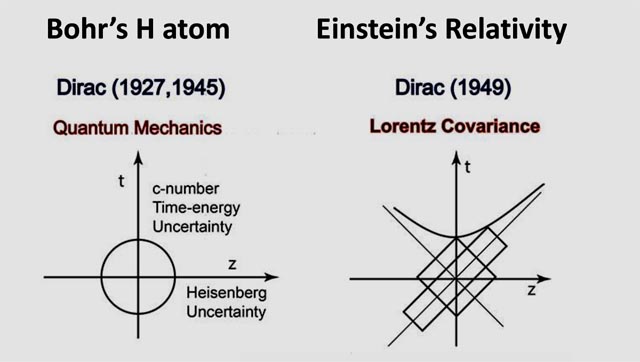
With these figures, you do not have to be a genius to synthesize them into the following figure for the moving bound state.
- I am not the first one to produce a new idea by combining two
figures.
It was Georg Wilhelm Friedrich Hegel who developed the philosophy of synthesis. This image is from Bertland Russel's book entitled Wisdom of the West. This is an easy-to-read book with many illustrations. I would say that this book could be called a philosophy book for children.
- Einstein was a Kant-enthusiast when he was a high-school student,
but he became a Hegelianist while developing his theories.
Click here for a published article on
this subject.
How was it possible for Einstein to become a Hegelian synthesizer from a Kantianist?
Click here for the annswer. - Even though Hegel documented the idea of synthesis in the 19th Century,
this process started much earlier in human history.
- Ancient Chinese produced their letters by drawing pictures. By combining
those tangible letters, they were able to produce an
abstract concept. Woman with her son leads to the abstract concept of
GOOD.
- Early Christians combined a woman with her infant son to produce the abstract
concept of God. This is one of the frescos
inside the Hagia Sofia
in Istanbul, Turkey. It is one of the oldest portraits of Virgin Mary
holding her infant boy.
- Ancient Chinese produced their letters by drawing pictures. By combining
those tangible letters, they were able to produce an
abstract concept. Woman with her son leads to the abstract concept of
GOOD.
- In arriving at the above figure of an ellipse on the truck, I have
to say that I had an excellent math background from my high school in
Korea (1951-54):
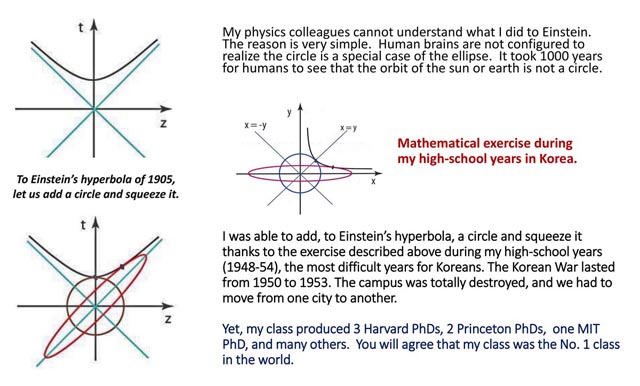
Click here to expand this figure.Click here for my high-school diary.
- How did I become interested in pictorial language in physics?
Go to Appidix 2.

|
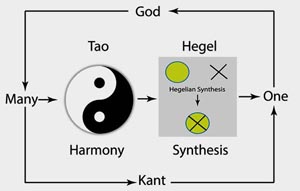
|

|
|
It is possible to produce an abstract concept by combining two tangible pictures. |
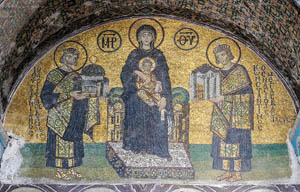
|
- The most cruel test in physics is to examine wether the mathematics
given here leads to observable effects in laboratories if not on streets.
While Bohr and Einstein could have discussed moving hydrogen atoms, there
are no observable atoms with speeds comparable with the speed of light.
Presumably, this is the reason why they did not worry about moving hydrogen
atoms.
- However, during the second half of the 20th Century, particle accelerators
routinely produced protons moving with speeds very close to that of light.
Yet, those protons are not hydrogen atoms.
- In 1964,
Murray Gell-Mann (1929-2019, Nobel-1969) formulated the quark model
for the hadrons,
including the proton. According this model, the proton is a quantum
bound state of the quarks just like the hydrogen atom. Unlike the hydrogen
atom, the proton can be accelerated.
- In 1969, Richard Feynman (1918-1988, Nobel-1965) noted that the ultra-fast proton appears like a collection of partons whose properties are quite different those of the quarks. Click here for a more detailed story of Feynman's partons.
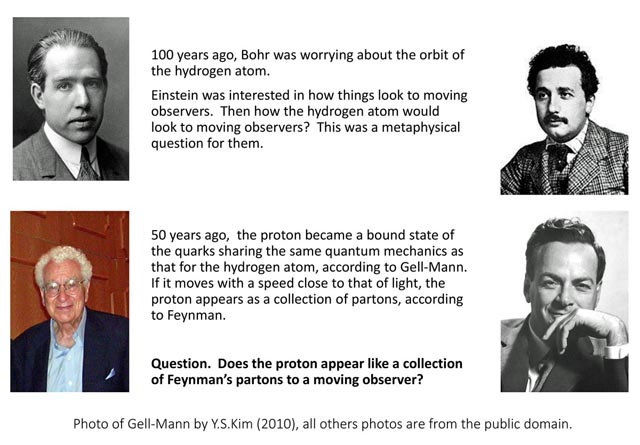 Click here to expand this figure.
Click here to expand this figure.
There are no hydrogen atoms moving with relativistic speeds, but modern accelerators produce protons moving with speeds close to that of light. Those protons are not Bohr's hydrogen atoms.
However, like the hydrogen atom, those protons are quantum bound states of the quarks. The bound states of the quarks are called
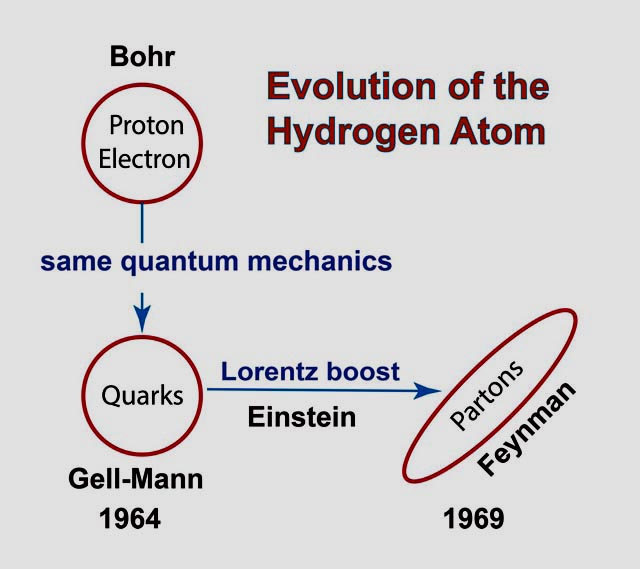 Click here to expand this figure.
Click here to expand this figure.
- In 1964,
Murray Gell-Mann (1929-2019, Nobel-1969) formulated the quark model
for the hadrons,
including the proton. According this model, the proton is a quantum
bound state of the quarks just like the hydrogen atom. Unlike the hydrogen
atom, the proton can be accelerated.
- We can now continue our discussion with the elliptic squeeze given able.
In the regime of harmonic oscillators, the momentum-energy wave function takes
the same Gaussian form as the space-time wave function, and it has the same
Lorentz-squeeze property, as shown in this figure:
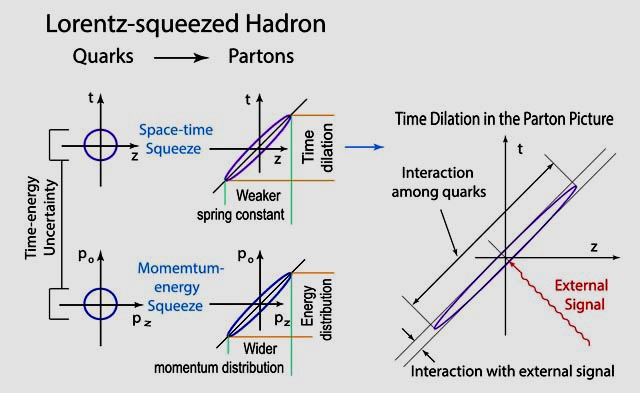 Click here to expand this figure.
Click here to expand this figure.
The story is OK so far, but there is the most cruel question in physics. Are these elliptic deformations observable in laboratories. The answer is YES as illustrated in this figure.
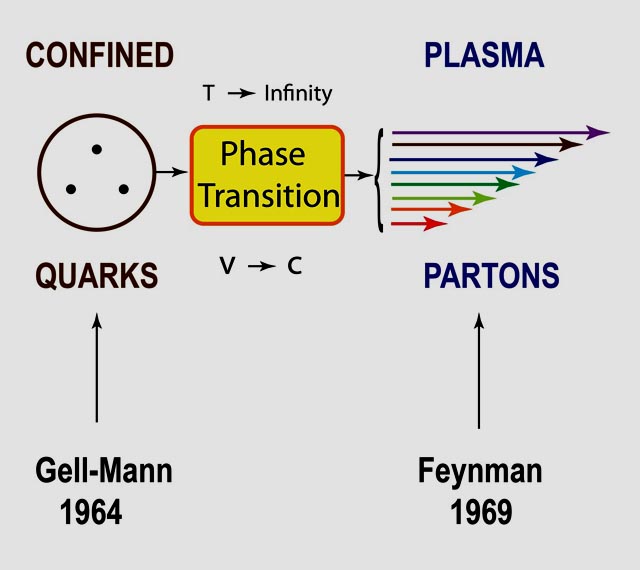 Click here to expand this figure.
Click here to expand this figure.
- In order to carry out the integration of Dirac's works, I needed the
mathematics formulated by
Eugene Paul Wigner (1902-1995, Nobel-1963).
In his 1939 paper on the Lorentz group , Wigner pointed out the internal space-time symmetries are like O(3) (three-dimensional rotation group) and E(2)(two-dimensional Euclidean group) for massive and massless particles respectively.
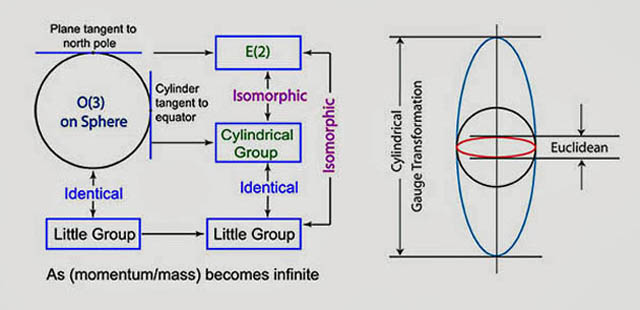 Click here to expand this figure.
Click here to expand this figure.
The question then is whether the O(3)-like little symmetry becomes the E(2)-like symmetry when the speed of this massive particle becomes reaches its limit: the speed of light. This question was addressed by Kim and Wigner in their 1987 paper published in the Journal of Mathematical Physics. Their result was reinforced in their paper of 1990.
The contents of these papers is summarized in the green row of the following table.
Einstein's World Massive/Slow between Massless/Fast Energy
MomentumE = p2/2m Einstein's
E = [(mc2)2 + (cp)2]1/2E = cp Helicity
Spin & GaugeS3
S1 S2Wigner's
Little GroupHelicity
Gauge Trans.Hadrons,
Bound StatesGell-Mann's
Quark ModelOne Lorentz-
Covariant EntityFeynman's
Parton Picture - Let us go back to the Bohr-Einstein issue. The hadron in the
quark model appears like a collection of Feynman's partons. This
aspect is summarized in the blue row of the above table. This
table was published in
my 1989 paper in the Physical Review Letters.
We can translate this table into this genealogical language:
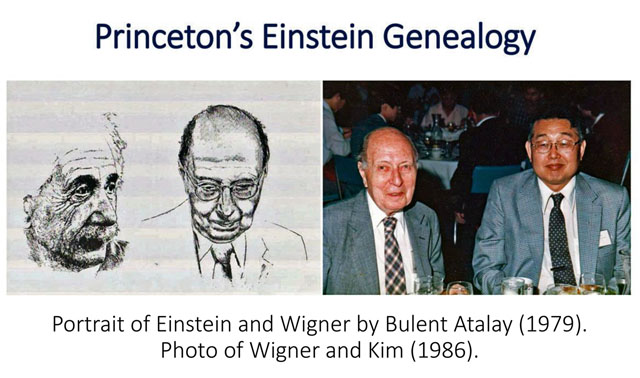
- What does the word "internal" mean? Let us examine this word
using Newtonian mechanics familiar to us. Newton formulated his
gravity law between two point particles. It took him 20 years to
apply his law for particles with non-zero size. How about inside
the particle with non-zero size, such as the earth. Then what happens
inside the earth?
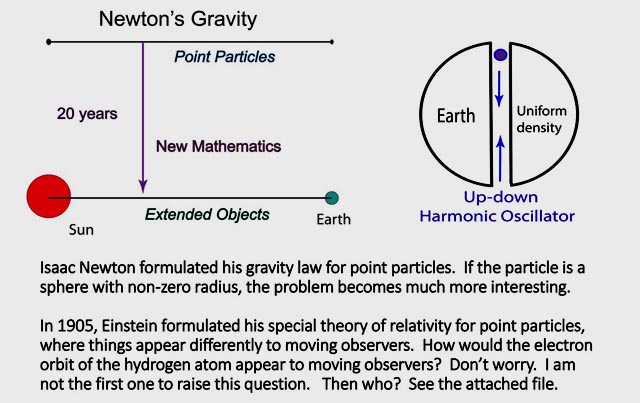 Click here to expand this figure.
Click here to expand this figure.
Click here for the attached file. - Einstein formulated his special theory of relativity for point
particles leading to his E = mc2, but he did not
extend his theory to the inside of the particle with a space-time
extension.
The simplest object with this space-time extension is the hydrogen atom, but there are no hydrogen atoms moving with relativistic speed. On the other hand, the proton in the quark model is an extended object just like the hydrogen atom. Thus, by observing fast-moving protons, we can settle the Bohr-Einstein issue.
- Indeed, Bohr and Einstein were God-like figures. The most we can
do is to build a bridge between them, as illustrated with the following
figure.

- Click here for more awards and recognitions.
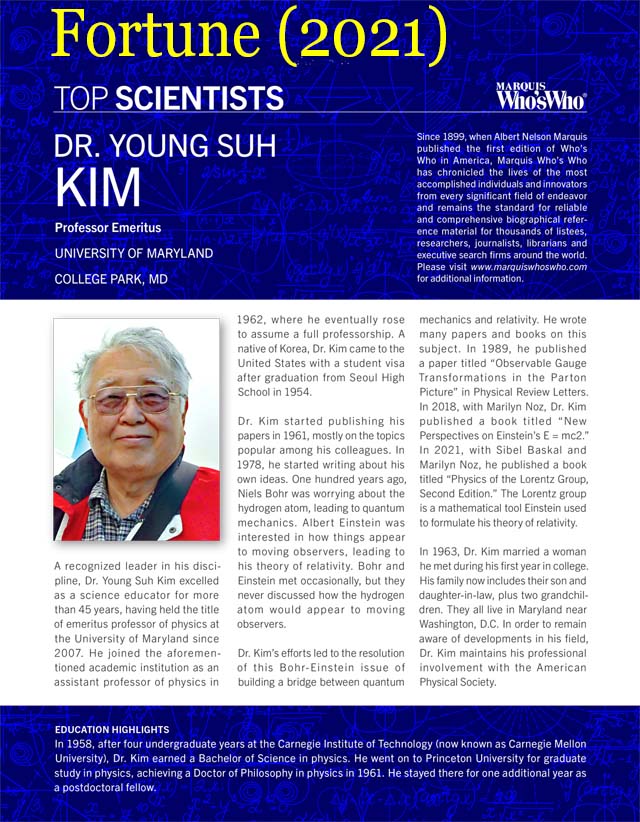 Click here to expand this figure.
Click here to expand this figure.
|
Appendix 1.
How did Toyotomi Hideyoshi appear to himself?
- After unifying Japan, he appeared to himself as the Emperor of the
world. China was the center of the world for Japanese at that time.
In order to position himself to the emperor's throne in Beijing, he
wanted to travel to China through the Korean Peninsula, and asked
Koreans to provide a safe pass-way for him.
Koreans said "Nyet" to him. He became angry and sent 150,000 sword-swinging (some with gun-powdered guns) Japanese troops to Korea. They slaughtered Koreans and burned down their houses. They were in Korea for seven years until Toyotomi died in 1598.
His destruction of Korea was so thorough that it took Koreans 100 years until 1700 (the period of King Sookjong) to rebuild their country.
- More recently, Korea was divided into two in 1945 after World War II,
and there was the Korean war from 1950 to 1953. The country was totally
destroyed again. These days, Korea is one of the most prosperous countries
in the world. It is not the first time for Koreans to reconstruct their
own country.
- My ancestors moved from a southern province of Korea to a northern
province during the Japanese atrocities (1592-98). The atrocity was
more intense in southern provinces closer to Japan.
My family moved to the South in 1946 to avoid the communist rule being set up in the North. I came to the United States in 1954, after high school graduation in Korea, and after the bloody Korean war (1950-53).

|
|
Appendix 2.
Where did I pick up the Wisdom of Cartoons?
-
John A. Wheeler was a distinguished professor of physics at Princeton University. He was not my thesis advisor, but I talked with him often on various issues. He is known as the best cartoonist in physics or in the world. Whenever I talked with him, I had to draw pictures and tables. Click here for my Wheeler page.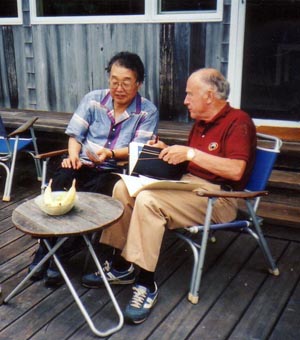
-
I visited Wheeler's summmer house in Maine during the summer of 1991.
I maintained my contact with him for many years after I left Princeton in 1962.
-
Richard Phillip Feynman (1918-1988, Nobel-1965) is known as the best physicist
born in the United States. He was Wheeler's student at Princeton. He introduced
his pictorial language into physics. It is called the
Feynman diagram
for the language for scattering processes. It is said that Feynman picked up the
pictorial language from John A. Wheeler.
- However, in 1970, Feynman said his diagrams,
though effective for scattering processes, are not adquate for bound states.
He then encouraged using harmonic oscillators. This was the starting point of
my own research line.
Copyright@2021 by Y.S.Kim
- Click here for my home page.
- My photo-biography.
- Style page.
- World travel page.
- My high school background.

I received my PhD degree from Princeton in 1961, seven years after high school graduation in 1954. This means that I did much of the ground work for the PhD degree during my high school years.
|
